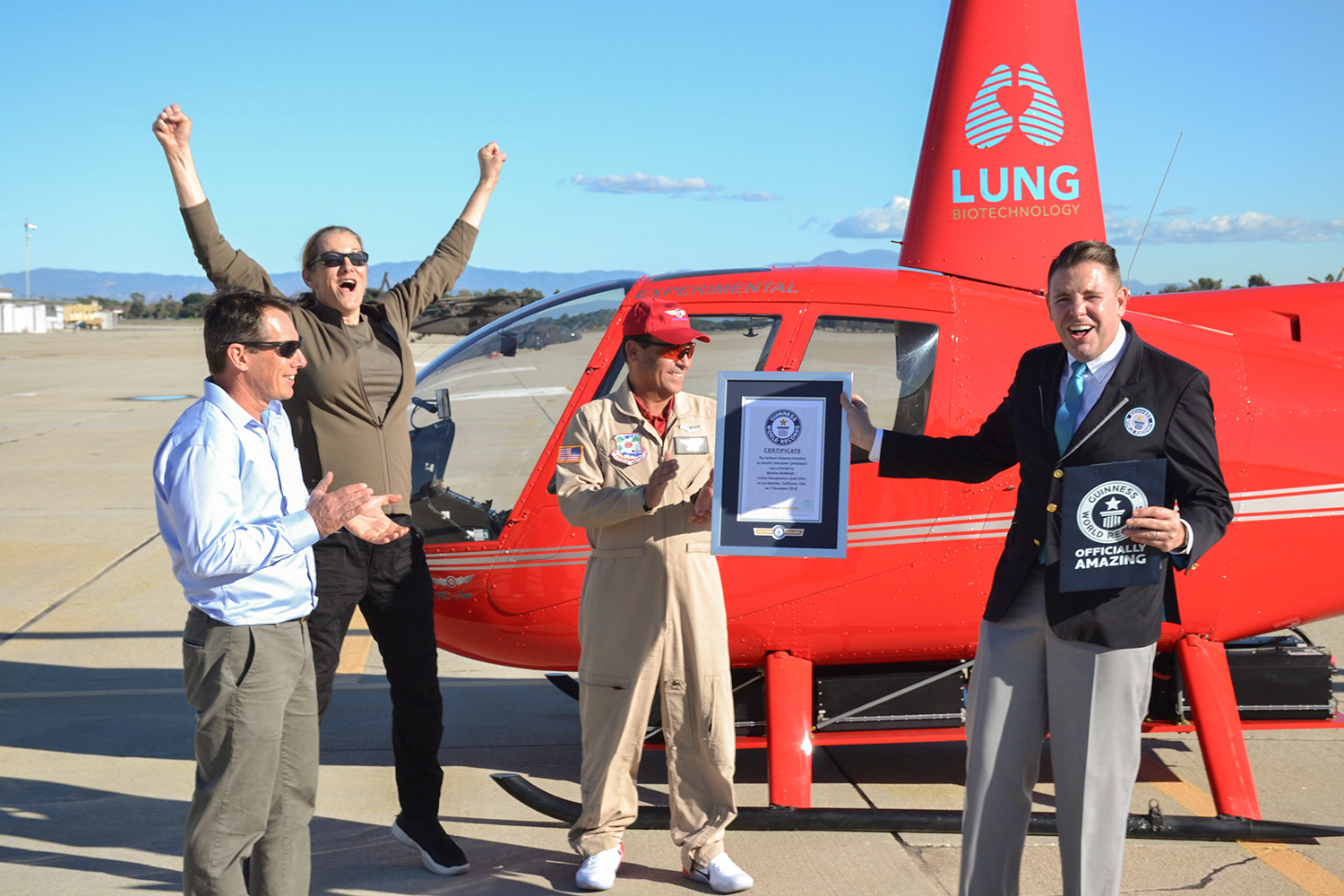
Persistence is omnipotent
Faced with daunting challenges throughout her life, Martine Rothblatt learned to push past the idea of the insurmountable. Her long list of accomplishments includes creating and commercializing satellite radio, founding a biotechnology company that seeks to provide an unlimited supply of transplantable organs, setting world records for electric flight and delving deep into the future of artificial intelligence with her work on digital immortality.
17 min read
Each month, our Journeys of Innovation series tells the stories of inventors or entrepreneurs whose groundbreaking innovations have made a positive difference in the world. This month, we focus on the journey on an innovator who’s pushing past all boundaries and breaking stereotypes with her achievements.
When Harold Rothblatt of La Mesa, California, lost the use of his legs after a terrible car accident in 1959, the doctors told him he would never walk or work as a dentist again. Determined to provide for his wife Rosa Lee and their two children, Martine (known to others as Martin until around age 40) and Janet, Harold began studying—from his hospital bed—to become an accountant.
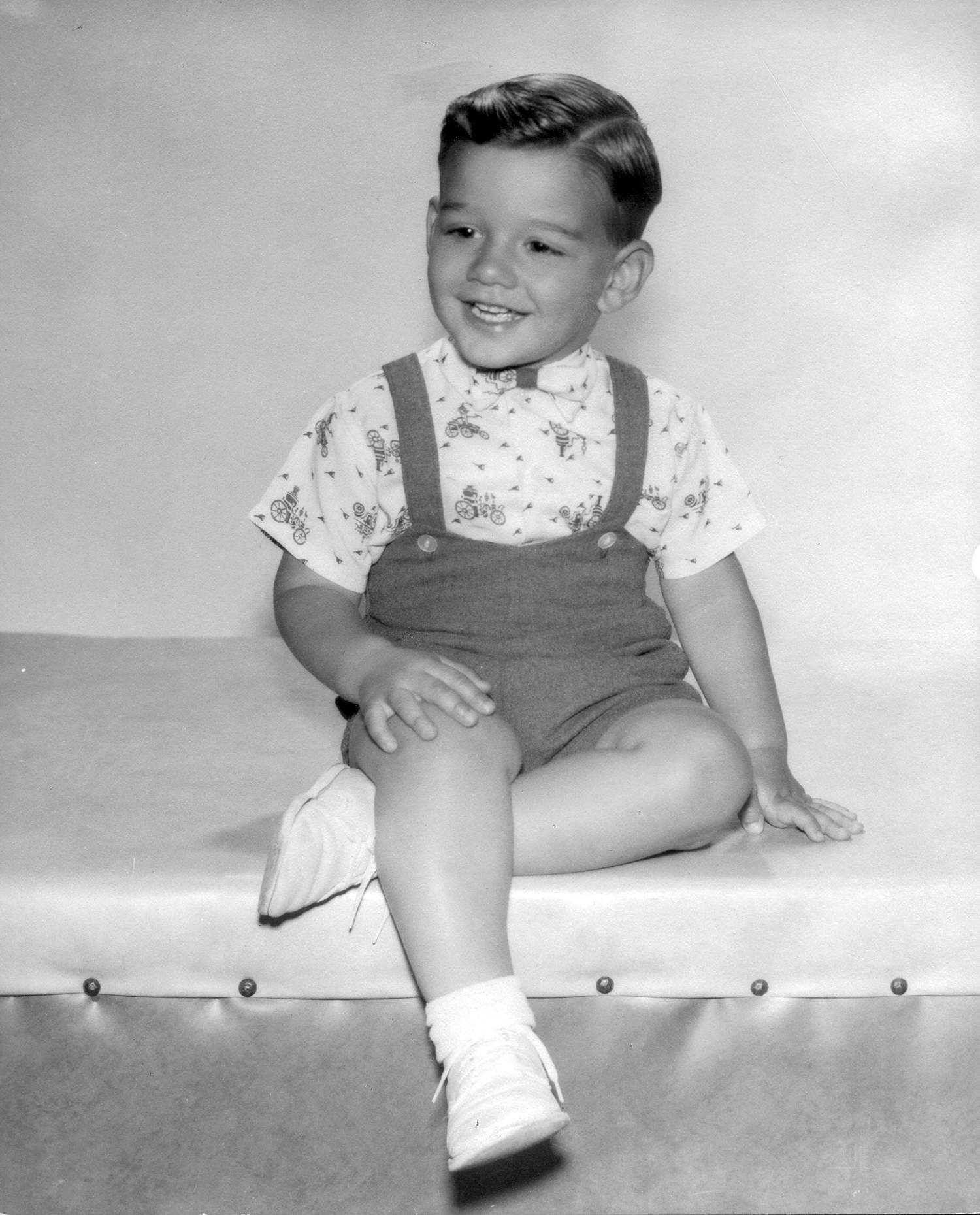
Martine Rothblatt (known then as Martin) in 1957 at three years old.
Five-year-old Martine didn’t know it yet, but Harold’s experience had set an example that later influenced her approach to a life without limits.
Rothblatt’s parents bucked conventional medical wisdom and painstakingly worked to find a cure for Harold’s disability. Well before the advent of the internet, and even before the widespread use of microfilm archives, their research and conversations with medical professionals led them to an experimental surgery at the Mayo Clinic that allowed Harold to walk again and continue his work as a dentist.
Raised in a happy home, Rothblatt grew to love the outdoors and the natural world, spending countless hours at the beach in Santa Monica and at points along California’s Pacific Coast Highway. A popular student in high school, she also played drums in a rock band at parties. But Rothblatt had a secret.
She said "the main challenge [she] faced" was the fear that if she "shared [her] true identity" she would be laughed at or made an outcast, so she kept it completely bottled up.
Despite her hidden struggles, Rothblatt was confident as a student and became frustrated by the slow pace of classes. She felt she could learn faster by reading on her own and grew to love biographies of famous inventors like Thomas Edison and George Westinghouse, who along with other inventors became her role models.
“I realized that it is not crazy to make something that never existed before; in fact, it seemed natural to the people I read about.”
As her innovative spirit grew, like many teenagers, she had disagreements with her parents. Rothblatt got into constant arguments with her father over things like breaking curfew and the length of her hair.
“Finally, in high school he told me either follow his rules, or get out of the house.” So she got out, moving into a small apartment with two high school dropouts. To make ends meet she began working eight-hour shifts rolling up and shipping Persian carpets after a full day of school.
“It was a challenge to not drop out of high school in these circumstances,” she said.
During her time away from home, Rothblatt maintained good grades and earned her father’s respect. A year after sending her away, Harold welcomed her home and offered her a job at his dental lab paying twice what she had been earning. She went on to graduate from high school on time and with honors.
After two years of undergraduate studies at the University of California, Los Angeles (UCLA), Rothblatt had yet to declare a major. It was the early 1970s, and the smog in Los Angeles was oppressive. The 10-mile commute to UCLA from her apartment in nearby Culver City regularly took an hour or more, and gang warfare and police shootings were escalating in Los Angeles, during a decade that saw a precipitous increase in violent crime all over the country.
“This was no way to live my life,” Rothblatt recalled. She resolved to escape to a utopian place where she could “enjoy each and every day.”
So began the journey that would lead her 10,000 miles east of Los Angeles to an archipelago in the Indian Ocean off the eastern coast of Africa, known as the Seychelles—home to vast swaths of untouched natural beauty she had only seen in brochures.
Along the way, Rothblatt set out to explore—beachcombing along the Kenyan coast, teaching English in Iran, and backpacking through Europe. When she finally made it to what she had hoped would be her Eden, she was disillusioned to find the same types of problems she had been attempting to escape in California. The beach was littered with glass, and trash was everywhere. Social tensions were high because of the large disparity between poor locals and rich tourists from South Africa who filled the hotels and ate from extravagant buffets. Worse yet, everyone seemed to accept these problems as immutable.
Disappointed, and needing to re-evaluate, Rothblatt found solace in music. She made ends meet by playing the electric piano in a band that performed at local hotels. Her journey to escape had led to this place, but a crucial discovery still awaited her.
In 1974, a bandmate invited her on a nighttime adventure that had a profound impact. They scrambled up Morne Seychellois, the tallest peak on the island of Mahé. Nestled amid the steep terrain and dense tropical forest was a relatively new U.S. Air Force space tracking station that provided support for NASA’s space shuttle program’s low-earth orbital missions. The radar antennae were housed under radomes, large round weatherproof enclosures several stories tall that protected the antennae.
“The technological beauty of that tracking station, and the inter-planetary scope of its mission, slammed into my soul so solidly that I resolved to spread that technology everywhere,” said Rothblatt. “I envisioned that satellite technology could unite the world in a way that we would care enough about the earth to stop polluting it, and we would care enough about each other to stop all the wars.”
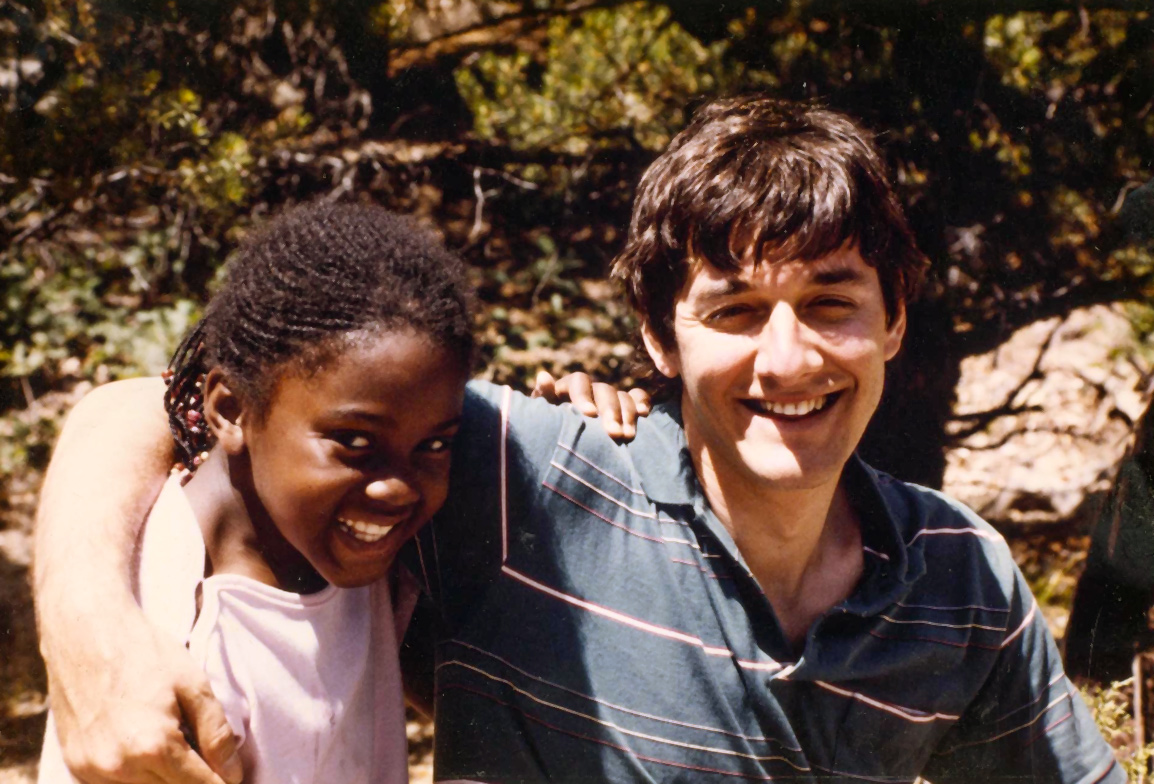
Rothblatt, seen here in 1980 enjoying the outdoors with daughter Sunee, has cultivated a love of nature since childhood.
Inspired by what she saw on that nighttime adventure, Rothblatt returned to UCLA and graduated in 1977 with a bachelor’s degree in communications and a thesis on international broadcast satellites.
Still, she thought she could do more. “There were no shortage of aerospace engineers, but very few experts in space law and finance,” said Rothblatt.
With that goal in mind, she continued her studies at UCLA, completing a Master of Business Administration and a Juris Doctor in 1981, with a focus on telecommunications policy law.
While immersed in earning those degrees, Rothblatt met Bina Aspen, a real estate agent. Both single parents to similarly aged children—Rothblatt had a child from a previous relationship after returning from the Seychelles—they quickly bonded, fell in love, and married in 1982. They adopted each other’s children and would later have two more together.
Fresh out of law school, Rothblatt moved her family across the country to Washington, D.C., and joined the law firm of Covington & Burling where, ironically, she lobbied the Federal Communications Commission (FCC) on behalf of clients who opposed the very technology on which she would later base her satellite radio startup.
Not enthusiastic about the work, Rothblatt left the job after a year to study astronomy at the University of Maryland before taking a job with Gerard O’Neill, a physicist whom she had admired, since her second stint at UCLA, for his extensive writing about human settlement in outer space. O’Neill had founded Geostar Corporation, which developed a vehicular tracking system, the precursor to modern global positioning satellite systems. Rothblatt worked as a lobbyist for the company.
Here, she finally got a real taste of what she could do in the world of satellites, and while she and O’Neill bonded over their mutual visions of building cities in space, O’Neill shared another idea: that they could use satellites to locate not only aircraft and vehicles, but also objects on Earth. This could prevent planes from crashing into one another, and it might even keep people from getting lost. O’Neill encouraged Rothblatt to get this project running.
As a musician, Rothblatt quickly realized that the same concept she was using to achieve O’Neill’s vision—the use of latitudinal and longitudinal position signals to locate and track the movement of vehicles—could also be used to transmit sound. She might even be able to listen to her favorite jazz artists on country roads, outside big cities, in places beyond the reach of radio signals— and receive satellite signal literally anywhere she could see the sky.
At a time when only AM and FM frequencies were commonly used, Rothblatt, a self-proclaimed “radio geek” with a broad understanding of the technological, legal, and business aspects of launching a satellite radio system, knew her idea would work. Yet she still needed capital and was repeatedly turned down by investors who doubted the concept. She ran into similar disbelief from the FCC when she applied for a license to operate.
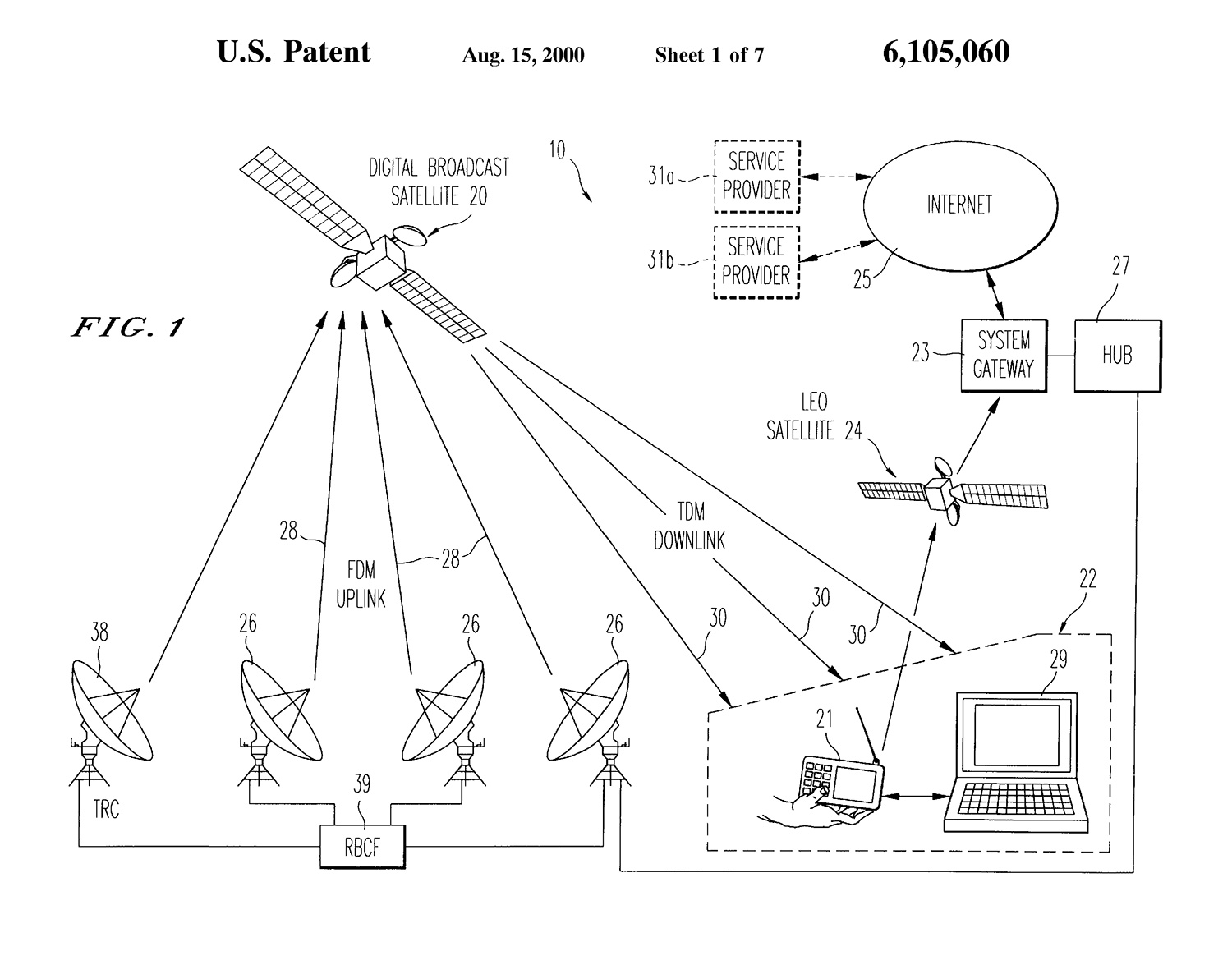
After founding Sirius Satellite Radio in 1990 and struggling to fund her vision, Rothblatt learned the value of patents with U.S. Patent No. 6,105,060, “System for providing global portable internet access using low earth orbit satellite and satellite direct radio broadcast system,” issued August 2000. Patent in hand, she went on to launch her radio broadcast service in 2002.
Both investors and the FCC questioned whether there would be any demand for the 24-hour broadcasting capacity Rothblatt said her discovery would facilitate. Would the satellite signal be reliable in overcast weather or through thick foliage? Who would even want to listen to it?
Rothblatt was not discouraged; she knew she just needed to adjust her approach.
“I had argued that exclusive FCC licenses were worth more than patents, but investors want as much market protection as they can get,” she said. “So, very quickly I began funding efforts to obtain patents on our inventions, thinking to myself that belts and suspenders are better than either one or the other.”
“I began to take a certain sense of pride in being awarded a patent.”
While the FCC and many others still had doubts, Rothblatt focused on her unwavering belief in what was possible. People telling her otherwise was nothing new. She had learned early in life, from the example of her parents, to never take “no” for an answer.
Faced with the daunting task of proving her theory, Rothblatt began creating a pseudo-satellite system that could be placed on top of a large building and would have the same broadcasting power as a satellite launched into space. Once finished, she loaded staff from the FCC into her car and took them on a tour through the expansive, heavily wooded Rock Creek Park in Washington, D.C. All along the drive, they could hear the broadcast signal— her satellite system worked.
Having achieved a partial win, Rothblatt still needed to prove to the FCC that there was public interest in using her system (the Communications Act of 1934 requires that broadcast licenses are awarded in a manner consistent with the “public interest, convenience, and necessity”). She began building a grass-roots movement and soon convinced more than 300 rural organizations—including search-and-rescue, aircraft, and flight groups—to sign on to show their interest in having 24 hours of constant broadcast.
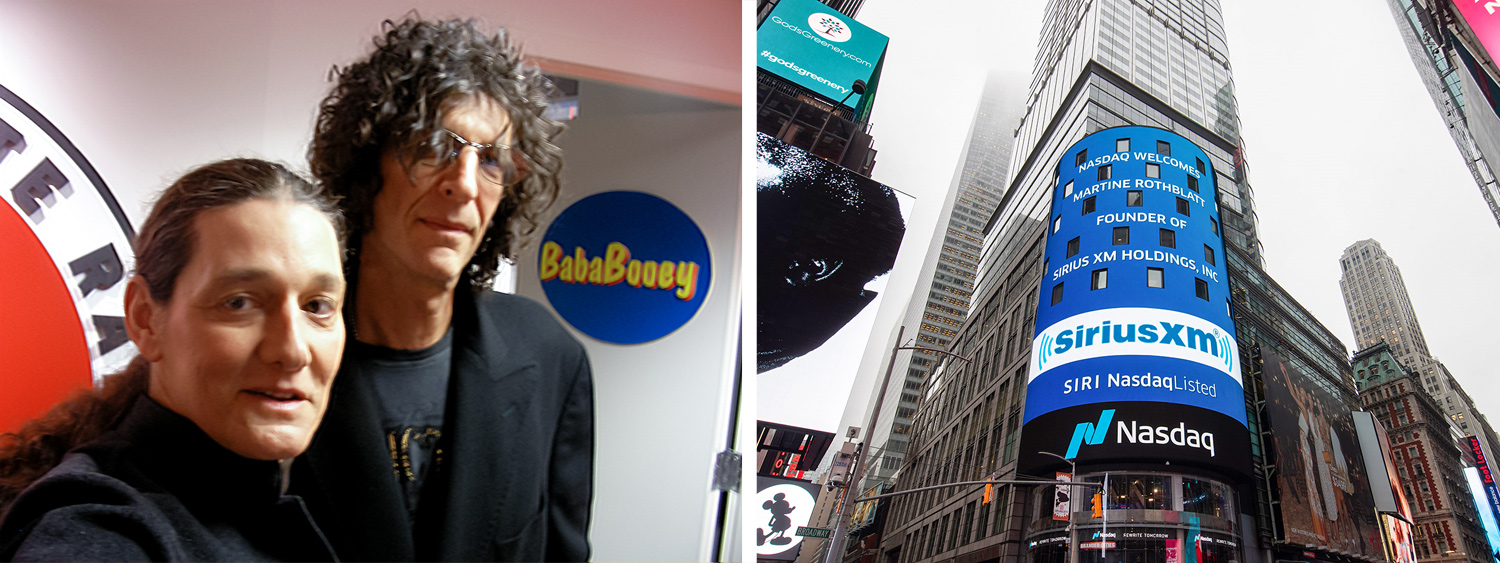
At left, Rothblatt with Howard Stern in the Sirius Satellite Radio studio in 2006. The company’s subscription base grew tenfold with the 2004 addition of Stern to its programming. “More people come up and hug me for being able to listen to Howard Stern on their SiriusXM radio than for the medicines that we've created that save people's lives,” said Rothblatt. At right, a welcome message in Times Square for Rothblatt’s September 2019 visit to the NASDAQ stock exchange celebrating the 25th anniversary of Sirius XM Holdings, Inc.’s listing. The company later merged with competitor XM Satellite Radio in 2008, becoming SiriusXM.
“To not only come up with an invention, to organize a company to make it happen, to raise the capital, to change the laws, to launch it, it’s a huge amount of effort. The whole time it’s like you’re walking on a tight-rope. You never know, if you make one mistake, that you’re gonna fall off the tight-rope and there could be nothing at the bottom,” said Rothblatt.
Despite what must have seemed like a circus performance of efforts to obtain licenses and funding, Rothblatt founded Sirius XM Holdings, Inc. in 1990 and launched Sirius Satellite Radio (today known as SiriusXM) in 2002. It was an instant success, garnering millions of subscribers within a few years, and then tens of millions of subscribers in 2004 after Howard Stern joined the programming. Rothblatt, now almost 40 years old, had achieved an important goal, but the part of herself she had kept concealed from the world could no longer be hidden.
Feeling confident in both her professional and personal life in the early 1990s, she confided in her wife Bina, and a short time later to the rest of their family, that she identified as a woman. Though her wife was completely surprised, Rothblatt said, “Bina’s immediate acceptance of my true-self was the first time in life that my mind felt free rather than in a mental prison.” As important was the acceptance of Rothblatt’s children and parents, which she described as the “add-on booster rockets” to everything she’s been able to invent since that time.
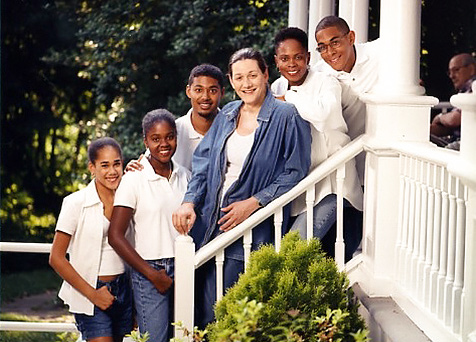
Rothblatt with her family. From left: Jenesis, Sunee, Eli, Martine, Bina, and Gabriel.
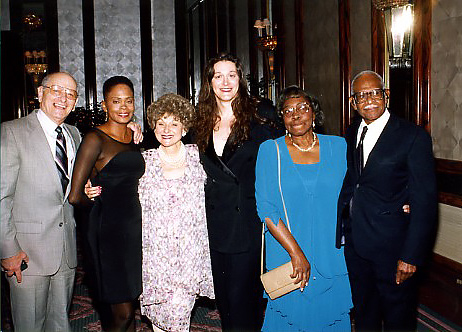
Rothblatt and wife with their parents at a family reunion. From left: Harold Rothblatt, Bina Rothblatt, Rosa Lee Rothblatt, Martine Rothblatt, Bertha Nobles, and Joe Smith.
Rothblatt would need this support from her wife, children, and parents to face one of her most personal challenges yet.
When still quite young, Rothblatt’s daughter Jenesis started becoming short of breath while on family ski trips. By the time she was 10, in 1994, she was on oxygen; the diagnosis was pulmonary hypertension (PAH). The fatal disease was progressively narrowing the arteries in her lungs—she would be lucky to survive five years.
“I was very fearful,” Rothblatt said, “because it was my daughter’s life at stake, and as a satellite engineer, I felt I had no control over biology.”
Rothblatt pleaded with experts to find a cure but was repeatedly turned down—even after offering to fund the research herself. Undeterred, and with no experience in the field, she dove headfirst into what she calls “the black box of biology,” switching focus from her successful career to finding a cure for her daughter.
“I didn’t really think much about the similarities, although surely my subconscious already had the template from my father’s experience,” she said.
Gradually, by breaking it down, Rothblatt “learned that while biology is the trickiest of machines, it is ultimately mechanistic, and with enough effort and ingenuity, it can be controlled to a greater or lesser degree.”
Using an approach she had been developing since high school, Rothblatt obsessively skimmed medical texts for their crux, focusing on the “30,000-foot view,” then scanned each of the references, going back to basic biology books when she didn’t understand terms. She even brought Jenesis to the library with her during stays at the Children’s National Medical Center in Washington, D.C., and tried to teach her what she was learning.
Through a colossal effort, the fledgling biologist found the key. The arteries that run into the lungs are different from the ones in the rest of the body; they transport deoxygenated blood into the lungs to be replenished, while other arteries carry blood full of oxygen away from the lungs to the rest of the body. That was it—she knew there had to be a drug that would communicate only with these distinctive arteries.
Even with that insight, Rothblatt still had a hard time convincing anyone to help her find the cure. The disease was rare—it only affected around 3,000 people in the country at the time—so no one was interested. Rothblatt sent out requests to many doctors, pleading for help, without much luck, until James Crow entered the picture.
A retired pharmacologist, Crow had developed what seemed like a promising early-stage drug for PAH, and Rothblatt was able to convince him to join her in starting a company organized around it. Together, they went on to develop Remodulin, which helped keep the blood pathways in the lungs open, and saved Jenesis’s life in the process. In 1996, two years after the initial diagnosis of Jenesis’s illness, Rothblatt and Crow founded LungRx—later renamed United Therapeutics due to a trademark dispute—with money Rothblatt made from taking SiriusXM public.
Though it kept her daughter alive, Remodulin was far from ideal. It had a short half-life, meaning it had to be continuously delivered through a heavy injection pump and wasn’t stable at room temperature. It needed to be packed in ice.
Jenesis wanted a delivery device more like the asthma inhalers her friends at school had. “You think my daughter would be grateful for saving her life,” joked Rothblatt . In reality, though, she knew the current solution was not compatible with a good quality of life, so the company got rid of the heavy pump and created an inhaled medication, Tyvaso. Finally, United Therapeutics created Orenitram, a pill taken three times a day that, like the two drugs before it, keeps the lung artery pathways open, only now with an improved quality of life. The company also developed Unituxin, a drug that cures 50% of patients with neuroblastoma—a very rare type of cancerous tumor that almost solely affects children.
“Persistence is omnipotent,” said Rothblatt. “If you don’t give up, you won’t fail.”
A relentlessly goal-driven person who has daily, weekly, and decadal aspirations that she rarely fails to achieve, Rothblatt continues to innovate at what seems like an ever-increasing pace. Wanting to tackle a larger problem she encountered when her daughter was first diagnosed with PAH, she has vowed to create a nearly unlimited supply of organs by the end of this decade.
Along these lines, her team at United Therapeutics is developing 3D-printed stem cell-grafted organs using fiber from genetically altered tobacco plants, while simultaneously restoring previously unusable human lungs to functioning status through an ex-vivo lung perfusion technology that allows the lungs to be flushed and ventilated in isolation, and later re-evaluated for health and suitability for transplant. Also, in what may seem like the stuff of science fiction, at Revivicor, a subsidiary company in Blacksburg, Virginia, staff are producing genetically engineered pigs with organs that are directly transplantable into humans.
To accelerate clinical trials, which currently take about a decade, Rothblatt’s team’s efforts revolve around developing “in silico” testing, as she calls it. By using this technique of creating digital models of body systems accurate to life, and including so many different genetic variations, she hopes that the United States Food and Drug Administration could be convinced to accept its use in clinical trials. In combination with machine learning, this testing could cut down trials to a matter of days.
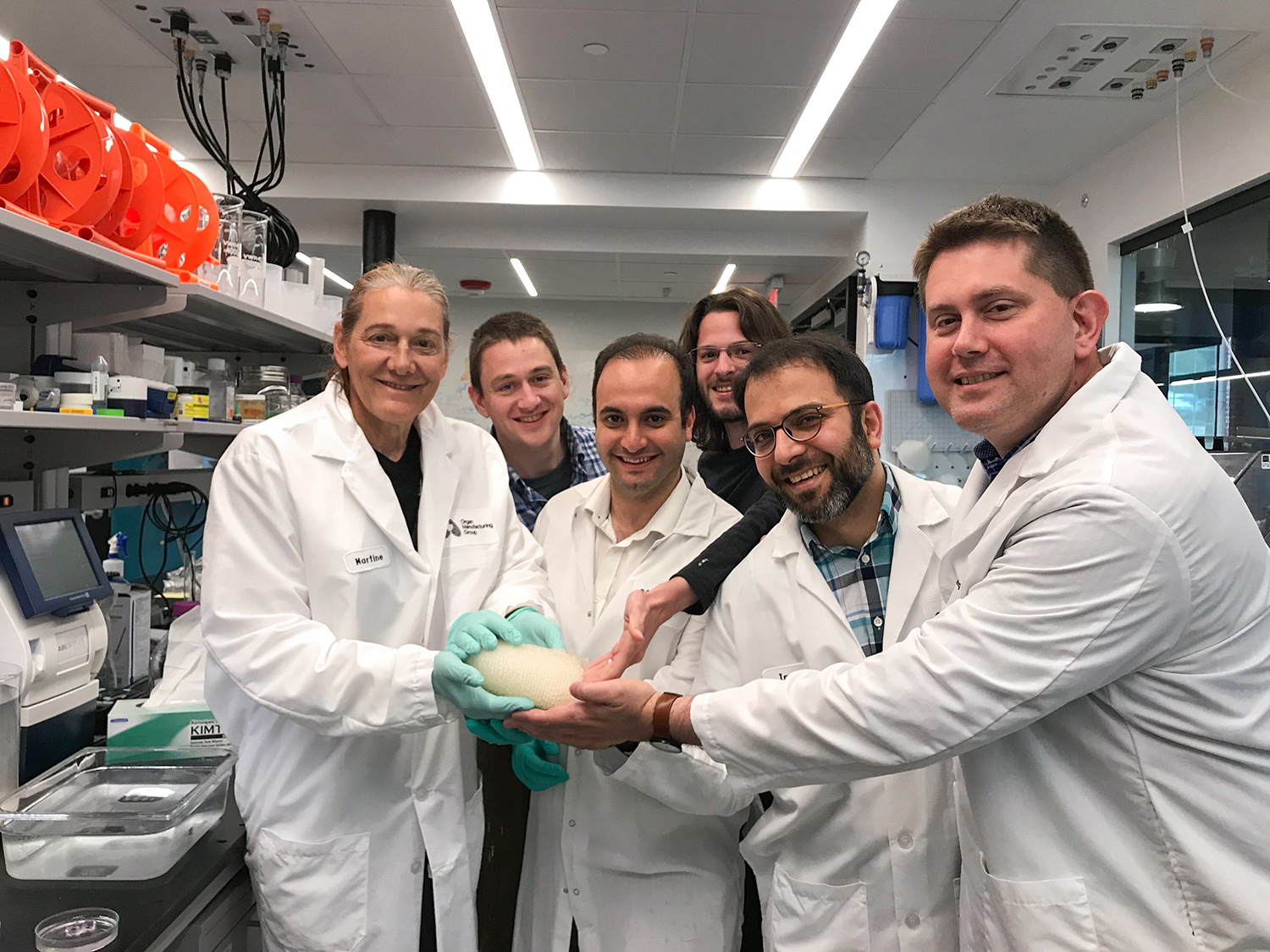
Rothblatt, left, and the team at United Therapeutics’ Organ Manufacturing Group in Manchester, N.H., holding a lung they are able to 3D-print from human collagen fiber grown in genetically modified tobacco plants with the help of Texas A&M University (Photo Courtesy of United Therapeutics).
Until this is developed, Rothblatt is settling for another somewhat unorthodox approach—testing the developed organs in cadavers—thereby skipping time-consuming animal testing and going straight to human trials.
Rothblatt boasted that her teams are “equally amped” to find solutions to the challenges they’re addressing, and setting goals with the teams that are reasonably attainable in five to 10 years is what allows her to accomplish so much while still keeping her sanity.
She is also so confident that her plan for developing unlimited organs will be successful, that she is hard at work on a system for their transport. Along with the team from Tier 1 Engineering, Rothblatt—a licensed pilot in addition to her many other accomplishments—has developed the world’s first electric helicopter, which holds Guinness Book records for distance, altitude, air speed, and payload.
Since leaving the air pollution of Los Angeles behind in the early 1970s and vowing to make the world better, Rothblatt has innovated in an environmentally friendly manner and encourages others to do so as well. In fact on the side of the Unisphere, the world’s largest net-zero energy building and home of United Therapeutics since 2018, a sign says, “This building is here to inspire hundreds of similar such buildings.”
Rothblatt has also been hard at work creating a “second cyber consciousness” of her wife Bina—the Bina48, currently in the form of a robotic face with a chat-bot-like functionality, programmed from hours of live interviews, that mimics the memories and values of the real Bina and functions through machine learning. Eventually, Rothblatt thinks forms of digital consciousness like the Bina48 will not only preserve our minds once our physical bodies pass, but will also allow us to process information faster and in doing so, free up space to help us relax and maintain balance in our lives.
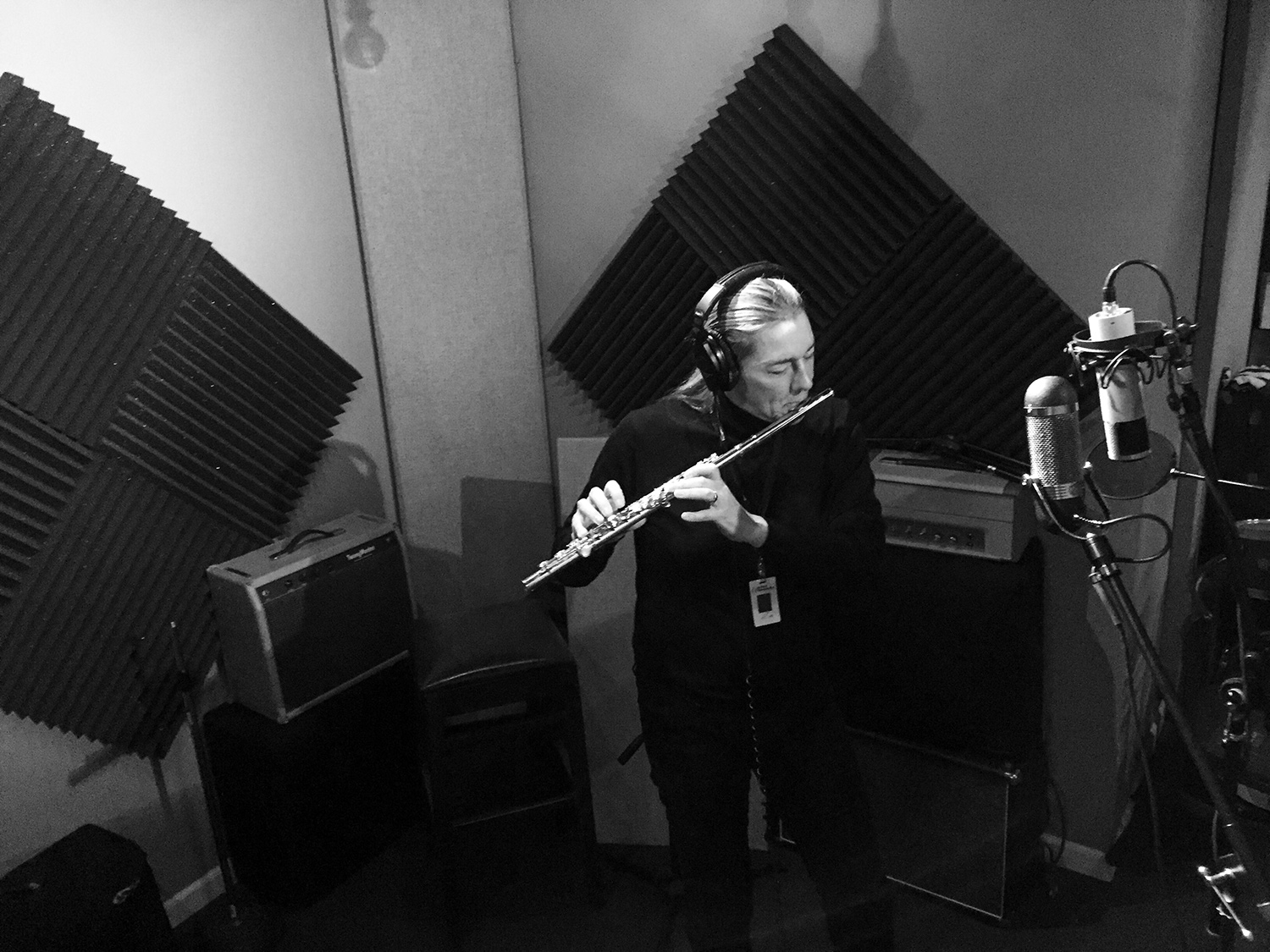
Rothblatt—a lifelong musician who plays the piano, flute, and drums—records in a Bethesda, Md., studio for a new release by the Alan Scott Band. Rothblatt's music inspired her entrepreneurial start, with satellite radio, and continues to help foster her creativity.
“I believe there is as much room for IP [intellectual property] in the realm of AI [artificial intelligence] as there was room for IP in the realm of agriculture, machinery, chemistry and electronics,” she said.
In conjunction with this work, on the last day of 2019, Rothblatt was awarded U.S. Patent No. 10,521,666 for the use of artificial intelligence as a cognitive enabler.
While accomplishing all this, Rothblatt manages to read voraciously—up to 12 books at a time, which she says “breeds creativity,” and continues to keep an ever-positive attitude and outlook by spending time with her family and playing her piano and flute.
Naturally, Rothblatt’s forays into second consciousness and other uncharted areas have their naysayers. But just as her parents bucked conventional wisdom after Harold’s accident, and just as she did when facing doubters of her vision for satellite radio and obstacles to saving her daughter’s life, Rothblatt continues to transcend limits and venture beyond the possible.
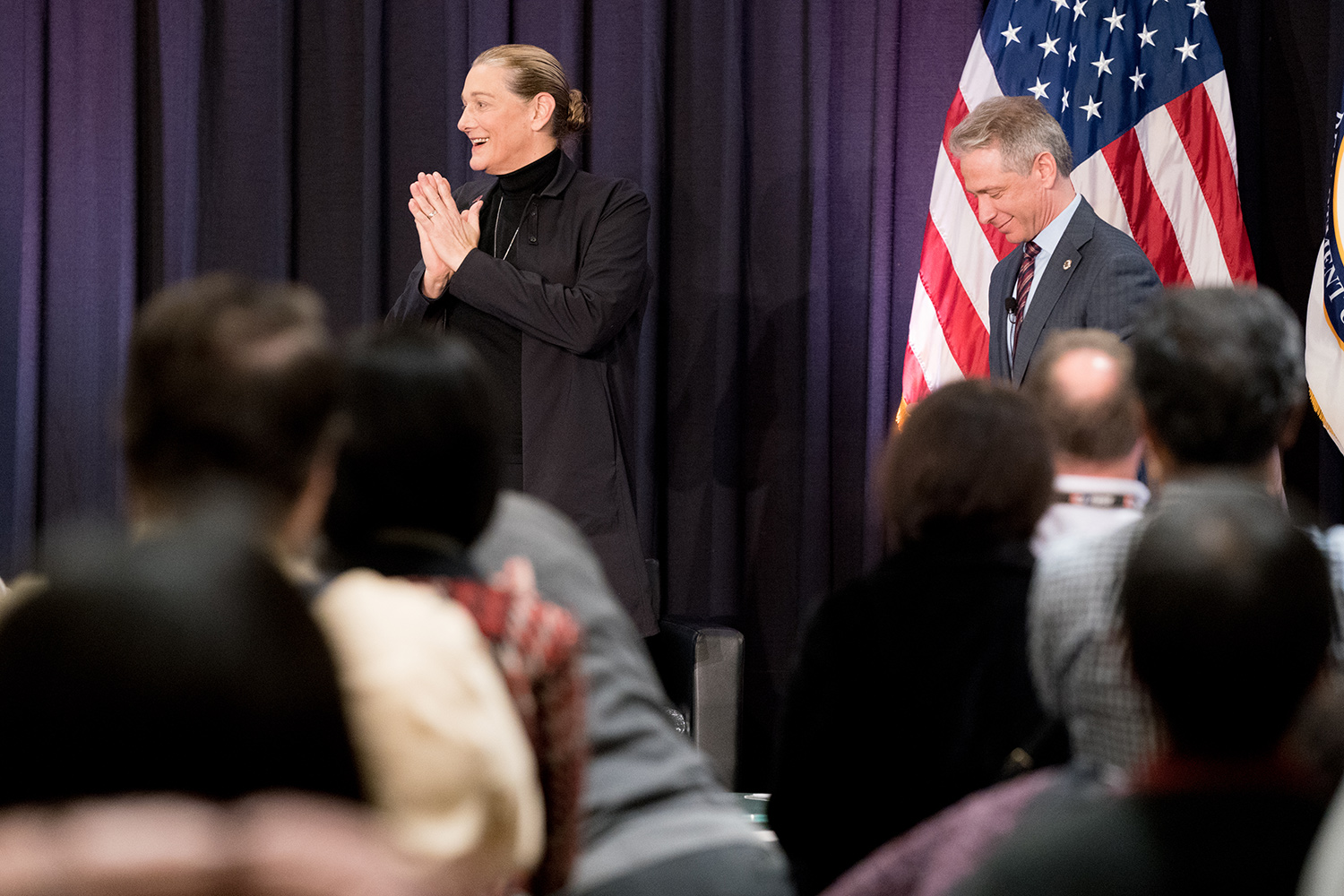
Rothblatt offers a sign of humble appreciation at the conclusion of a live presentation and interview at the United States Patent and Trademark Office hosted by Andrei Iancu, Under Secretary of Commerce for Intellectual Property and Director of the USPTO. (Photo by Jay Premack/USPTO.)
Credits
Produced by the USPTO Office of the Chief Communications Officer. For feedback or questions, please contact inventorstories@uspto.gov.
Story by Rebecca Fritchman and Jay Premack. Pictures, including homepage and leading image, provided by Martine Rothblatt unless otherwise noted. Additional contributions from Eric Atkisson, Marie Ladino, and Jeff Isaacs.
The image at the beginning of this story features Rothblatt and the team from Tier 1 Engineering celebrate winning a Guinness Book of World Records award for the farthest distance traveled (56.82 kilometers) by an electric helicopter, on December 7, 2018. Together they developed an optionally-piloted electric helicopter as part of Rothblatt's mission to be able to deliver organs for transplant.
References
USPTO Speaker Series, featuring Martine Rothblatt, December 4, 2019, https://www.uspto.gov/learning-and-resources/uspto-videos/speaker-series-martine-rothblatt.
What it takes podcast, featuring Martine Rothblatt, December 2, 2019, https://whatittakes.simplecast.com/episodes/martine-rothblatt-transcending-boundaries-Xyjj3N5X.



